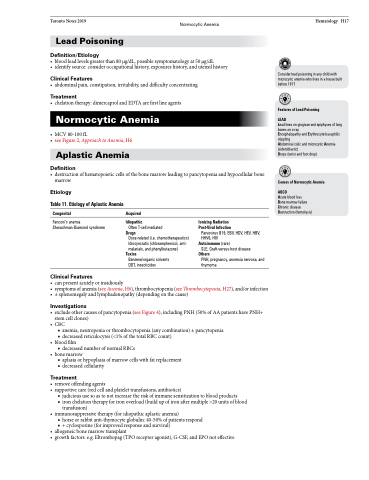Page 557 - TNFlipTest
P. 557
Toronto Notes 2019 Normocytic Anemia Lead Poisoning
Definition/Etiology
• bloodleadlevelsgreaterthan80μg/dL,possiblesymptomatologyat50μg/dL
• identifysource:consideroccupationalhistory,exposureshistory,andutensilhistory
Clinical Features
• abdominalpain,constipation,irritability,anddifficultyconcentrating
Treatment
• chelationtherapy:dimercaprolandEDTAarefirstlineagents
Normocytic Anemia
• MCV80-100fL
• seeFigure2,ApproachtoAnemia,H6
Aplastic Anemia
Definition
• destructionofhematopoieticcellsofthebonemarrowleadingtopancytopeniaandhypocellularbone marrow
Hematology H17
Consider lead poisoning in any child with microcytic anemia who lives in a house built before 1977
Features of Lead Poisoning
LEAD
Lead lines on gingivae and epiphyses of long bones on x-ray
Encephalopathy and Erythrocyte basophilic stippling
Abdominal colic and microcytic Anemia (sideroblastic)
Drops (wrist and foot drop)
Causes of Normocytic Anemia
ABCD
Acute blood loss
Bone marrow failure Chronic disease Destruction (hemolysis)
Etiology
Table 11. Etiology of Aplastic Anemia
Congenital
Fanconi’s anemia Shwachman-Diamond syndrome
Clinical Features
Acquired
Idiopathic
Often T-cell mediated
Drugs
Dose-related (i.e. chemotherapeutics) Idiosyncratic (chloramphenicol, anti- malarials, and phenylbutazone)
Toxins
Benzene/organic solvents DDT, insecticides
Ionizing Radiation Post-Viral Infection
Parvovirus B19, EBV, HDV, HEV, HBV,
HHV6, HIV Autoimmune (rare)
SLE, Graft-versus-host disease
Others
PNH, pregnancy, anorexia nervosa, and thymoma
• canpresentacutelyorinsidiously
• symptomsofanemia(seeAnemia,H6),thrombocytopenia(seeThrombocytopenia,H27),and/orinfection • ±splenomegalyandlymphadenopathy(dependingonthecause)
Investigations
• excludeothercausesofpancytopenia(seeFigure4),includingPNH(50%ofAApatientshavePNH+ stem cell clones)
• CBC
■ anemia, neutropenia or thrombocytopenia (any combination) ± pancytopenia ■ decreased reticulocytes (<1% of the total RBC count)
• bloodfilm
■ decreased number of normal RBCs
• bonemarrow
■ aplasia or hypoplasia of marrow cells with fat replacement ■ decreased cellularity
Treatment
• removeoffendingagents
• supportivecare(redcellandplatelettransfusions,antibiotics)
■ judicious use so as to not increase the risk of immune sensitization to blood products
■ iron chelation therapy for iron overload (build up of iron after multiple >20 units of blood
transfusion)
• immunosuppressivetherapy(foridiopathicaplasticanemia)
■ horse or rabbit anti-thymocyte globulin: 40-50% of patients respond
■ + cyclosporine (for improved response and survival)
• allogeneicbonemarrowtransplant
• growthfactors:e.g.Eltrombopag(TPOreceptoragonist),G-CSF,andEPOnoteffective


